Dark Passage Blu-ray Movie
HomeDark Passage Blu-ray Movie 
Warner Archive CollectionWarner Bros. | 1947 | 106 min | Not rated | May 17, 2016
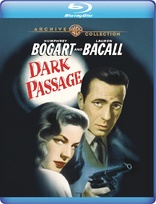
Movie rating
7.6 | / 10 |
Blu-ray rating
| Users | 5.0 | |
| Reviewer | 4.0 | |
| Overall | 4.1 |
Overview
Dark Passage (1947)
A man convicted of murdering his wife escapes from prison and works with a mysterious woman to prove his innocence.
Starring: Humphrey Bogart, Lauren Bacall, Bruce Bennett (I), Agnes Moorehead, Tom D'AndreaDirector: Delmer Daves
| Film-Noir | 100% |
| Thriller | Insignificant |
Specifications
Video
Video codec: MPEG-4 AVC
Video resolution: 1080p
Aspect ratio: 1.36:1
Original aspect ratio: 1.37:1
Audio
English: DTS-HD Master Audio 2.0 Mono (48kHz, 24-bit)
French: Dolby Digital 2.0 Mono (192 kbps)
Spanish: Dolby Digital 2.0 Mono (192 kbps)
Spanish: Dolby Digital 2.0 Mono (192 kbps)
BDInfo verified. Spanish = Latin & Castillian
Subtitles
English SDH, French, Japanese, Spanish
Discs
50GB Blu-ray Disc
Single disc (1 BD)
Playback
Region free
Review
Rating summary
| Movie | 3.5 | |
| Video | 5.0 | |
| Audio | 4.5 | |
| Extras | 2.0 | |
| Overall | 4.0 |
Dark Passage Blu-ray Movie Review
Invisible Man
Reviewed by Michael Reuben May 15, 2016Of all the leading roles played by Humphrey Bogart, none is as vaguely defined as Vincent Parry
in Dark Passage. Except for an unhappy marriage, Vincent has no back story; we learn almost
nothing about his life before the incarceration from which he escapes as the film opens. Neither a
hero nor an anti-hero, Vincent is motivated solely by his immediate predicament, which is to
avoid being recaptured and returned to prison.
The indistinctness of Vincent's character is matched by the film's radical approach to telling his
story. Writer/director Delmer Daves (The Red
House and 3:10 to Yuma) keeps
Vincent
off the screen for the film's first act, except for a few shots where he is shrouded in shadow. Vincent
spends the second act deprived of speech with his face swathed in bandages. Not until the final
thirty-five minutes of Dark Passage does Vincent appear onscreen with Bogart's familiar face,
which is a risky narrative gambit for a film promoted as a vehicle starring one of Warner's most
popular screen icons. Studio head Jack Warner was appalled when he saw the film, and
audiences were disappointed. Of the four projects pairing Bogart with Lauren Bacall, Dark
Passage was the least successful at the box office.
Today, though, viewers are more accustomed to "point of view" photography; indeed, the found-footage genre has made it such a gimmick that the
restraint of Daves' approach is refreshing. Dark Passage also benefits from an elegant performance by Bacall, who had become
choosy about her parts after being miscast by the studio in Confidential
Agent (necessitating a career reboot, aided by reshoots, in The Big Sleep). Bogart spotted the potential role for his new wife when he first read the novel by David Goodis
on
which Dark Passage is based, and he was instrumental in persuading Warner to make the film under the direction of Daves, who had
co-scripted Bogart's breakthrough role in The
Petrified Forest. Despite the film's initial poor reception, time has ratified Bogart's instincts, because Bacall's ambiguous heroine, part
guardian angel, part femme fatale, gives Dark Passage its emotional core.
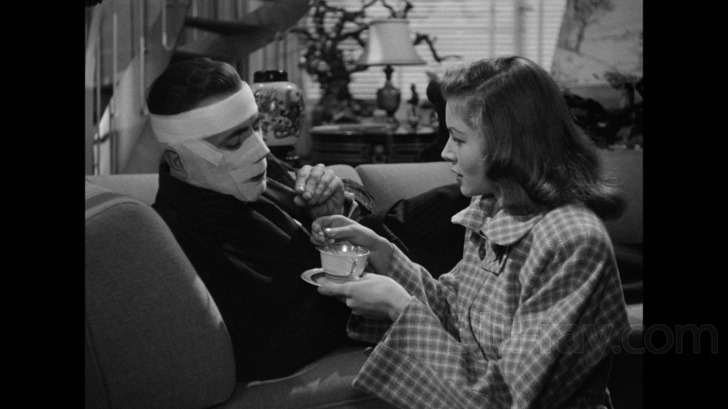
Wrongfully convicted of murdering his wife and sentenced to life in prison, Vincent Parry (Bogart) escapes from the state penitentiary at San Quentin by hiding on a supply truck. When we first glimpse Vincent, only his hands are visible, as he grasps the edge of the barrel that conceals him. Returning to San Francisco, Vincent is given a new face by a back-alley plastic surgeon, Dr. Coley (Houseley Stevenson), whose radical techniques have led to his ouster from the medical profession. (He's an early version of the doctor played by Peter Stormare in Minority Report who gives Tom Cruise a new identity.) Dr. Coley may be eccentric and intimidating, but his skills are effective. When Vincent removes the bandages after a week's recovery, he looks nothing like the photograph being circulated to the public by law enforcement. (The face used in the photo is that of actor Frank Wilcox.)
Dr. Coley is only one of many questionable characters that Vincent encounters after his escape. With the camera adopting Vincent's point of view, everyone he meets appears dubious or grotesque (sometimes both). A passing motorist (Clifton Young) who picks up Vincent hitchhiking near the prison asks too many uncomfortable questions. Vincent's former buddy, an amateur trumpet player named George Fellsinger (Rory Mallinson), doesn't look entirely happy to see his old friend, even as he offers him sanctuary. A cabby named Sam (Tom D'Andrea), who takes Vincent to Dr. Coley, talks too much and seems overly eager to aid an escaped convict. And then there's Madge Rapf (Agnes Moorehead), the prosecution's chief witness at Vincent's trial, who surfaces almost as soon as the escapee reaches San Francisco, as if instinct—or maybe fate—is drawing them together.
But the most important face entering Vincent's field of vision is that of an amateur painter, Irene Jansen (Bacall), who appears out of nowhere to rescue him from a difficult situation. Irene hides him, provides cash and new clothing, and nurses Vincent while he heals from facial surgery. Why such devotion to a man she's never met? As Irene gradually reveals her reasons, even contemporary viewers must have wondered whether she might be concealing a hidden agenda.
Whatever Vincent did for a living before his life took an unexpected detour, he's no mastermind. He doesn't seem to have thought through his escape beyond the initial impulse of stowing away on the prison truck, and his efforts at exoneration are haphazard and improvised. He uncovers the real murderer more by luck and coincidence than by astute investigation (and the revelation doesn’t do him any good, for reasons I’ll leave for readers to discover for themselves). Dark Passage is a classic example of the use of star power to fill in the outlines of a character who would otherwise remain no more than a sketch. We project the wiliness of the typical Bogart hero onto Vincent, even as his conduct routinely demonstrates that he's not especially clever. Dark Passage supports its slender plot on the strength of Bogart's presence—his voice off-camera is just as distinctive as the face that emerges from Vincent's bandages—and on a superb ensemble cast who make each supporting character interesting and memorable. Above all, it is Bacall's Irene who provides the hopeful prospect of a happy outcome, even as everything seems to conspire to return Vincent to San Quentin.
Dark Passage Blu-ray Movie, Video Quality 
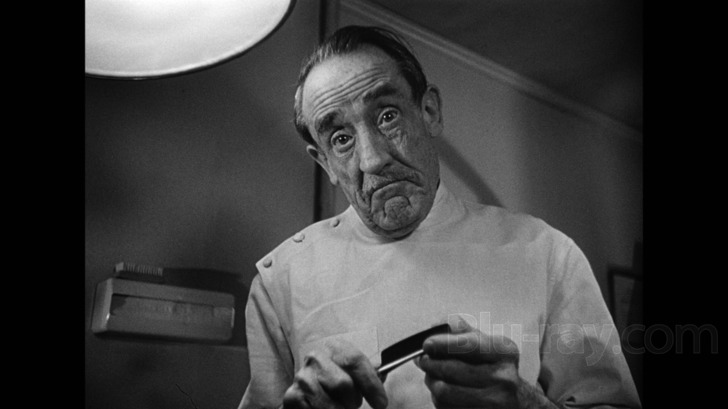
Dark Passage was photographed by Sid Hickox, the cinematographer of To Have and Have Not
and The Big Sleep. A newly developed
handheld camera was used to capture the many point-of-view shots. Director Delmer Daves was allowed to shoot much of the film on location in San
Francisco, which made Dark Passage one in a line of notable films (including Vertigo and
Bullitt) that have exploited the city's distinctive topography for
visual interest.
For the film's Blu-ray debut, the Warner Archive Collection has newly scanned (at 2K) a recently
manufactured fine-grain master positive made from the original nitrate negative. As with all
films of this vintage, the negative had accumulated substantial wear-and-tear, necessitating
extensive restoration work to repair damage and remove dirt and scratches. The result on this
1080p, AVC-encoded Blu-ray is a lustrous black-and-white image that deftly handles Dark
Passage's mixture of film noir shadows and brightly lit indoor and daytime scenes. Superior
detail enhances the many shots in which the camera remains fixed on the face of someone
speaking to Vincent, seen from his point of view. The creases and crags on Dr. Coley make his
jokes about the ease with which a plastic surgeon can ruin someone's face all the more
intimidating, while the delicacy of Irene's features brings out her radiance (and sometimes makes
her seem too good to be true). The San Francisco locations are reproduced with picture-postcard
clarity, including the distinctive Art Deco building used for Irene's apartment, which
subsequently became a tourist attraction. Blacks are deep, whites are accurate, shades of gray are
well delineated, and the film's natural grain pattern is finely resolved. Even the opticals depicting
Vincent's anesthesia-induced nightmare are remarkably crisp and detailed. Only the sequences
utilizing rear projection show a drop-off in quality, and that is inherent in the source.
WAC has mastered Dark Passage at an average bitrate of 33.91 Mbps, which is slightly under its
usual target but is sufficient to ensure a superior encode.
Dark Passage Blu-ray Movie, Audio Quality 
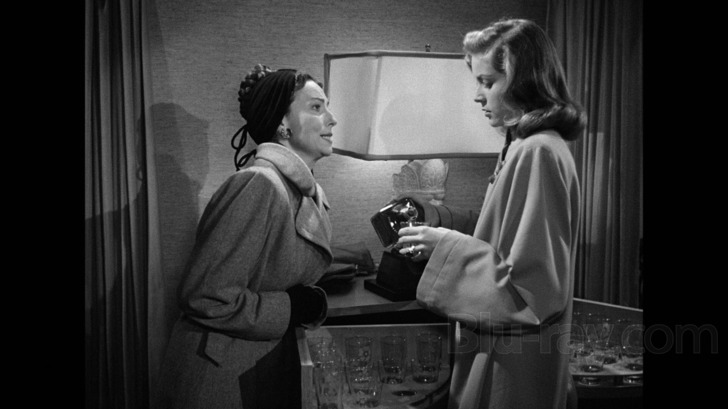
Dark Passage's original mono soundtrack has been derived from the optical track of the master positive and encoded in lossless DTS-HD MA 2.0. Digital cleanup has eliminated any pops, clicks or hiss, and the track cleanly reproduces the film's dialogue and sound effects, including the threatening sirens triggered by Vincent's escape. The score by the prolific Franz Waxman (Suspicion) plays with good fidelity and dynamic range for a soundtrack of this vintage, contributing both suspense and, when appropriate, tender emotion.
Dark Passage Blu-ray Movie, Special Features and Extras 
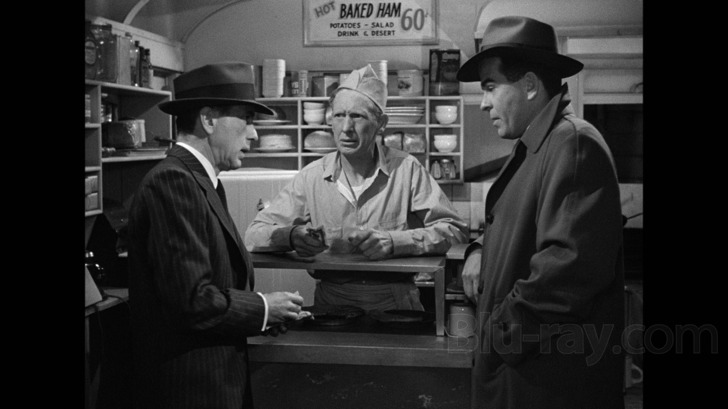
The extras have been ported over from Warner's DVD of Dark Passage, first released in 2003
and reissued in 2006. Both the trailer and the cartoon have been remastered in 1080p.
- Hold Your Breath and Cross Your Fingers (480i; 1.33:1; 10:32): This TCM featurette on the making of Dark Passage is narrated by actor Monte Markham. The interviewees include critic Leonard Maltin, TCM's Robert Osborne and Bogart biographer Eric Lax. Of particular note is the account of Bogart's participation in a protest against the actions of the House Un-American Activities Committee and his subsequent renunciation of those efforts, all of which may have played a role in the film's weak box office.
- Slick Hare (1080p; 1.37:1; 7:43): This Merrie Melody from 1947 is set in a star-studded Hollywood restaurant, where an animated Humphrey Bogart orders "fried rabbit" and waiter Elmer Fudd does his best to oblige.
- Theatrical Trailer (1080p; 1.37:1; 2:15): The trailer is narrated by a theater usher who reminds viewers how much they loved Bogart and Bacall in To Have and Have Not and The Big Sleep. Note how the trailer carefully omits any of the subjective "point of view" shots for which Dark Passage is best known.
Dark Passage Blu-ray Movie, Overall Score and Recommendation 
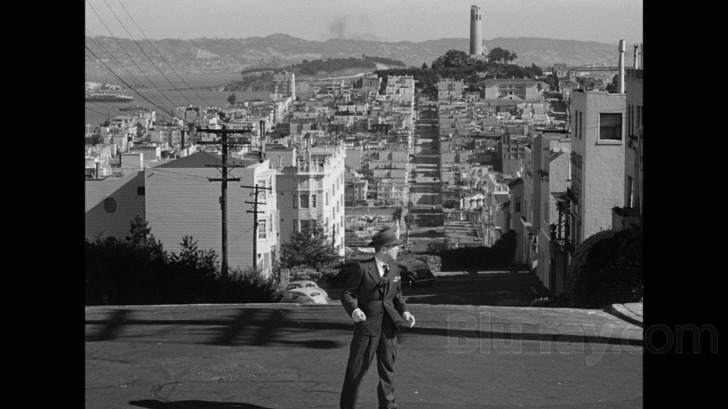
With the release of The Big Sleep, Key
Largo and now Dark Passage, WAC has nearly completed the quartet of films pairing Bogart and Bacall, one of Hollywood's
most
storied couples. Only the film that started it all, To Have and Have Not, remains unreleased on Blu-ray
(an omission that I expect to be remedied soon). The boldness of Dark Passage's stylistic
experiments may have dampened the film's original reception, but they have also kept it novel
and intriguing. WAC's presentation is first-rate and highly recommended.
Similar titles
Similar titles you might also like

The Big Sleep
Warner Archive Collection
1946

This Gun for Hire
1942

White Heat
1949

Out of the Past
Warner Archive Collection
1947

Key Largo
Warner Archive Collection
1948

To Have and Have Not
Warner Archive Collection
1944

I Confess
Warner Archive Collection
1953

Murder, My Sweet
Warner Archive Collection
1944

High Sierra
1941

The Strange Love of Martha Ivers
4K Restoration
1946

He Walked by Night
4K Restoration
1948

Leave Her to Heaven
1945

The Desperate Hours
1955

The Hitch-Hiker
1953

Kiss the Blood Off My Hands
1948

The Window
Warner Archive Collection
1949

Black Angel
Arrow Academy
1946

Raw Deal
Reissue | Special Edition
1948

I Wake Up Screaming
Hot Spot
1941

Hell on Frisco Bay
1955